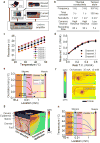Multifunctional skin-like electronics for quantitative, clinical monitoring of cutaneous wound healing
- PMID: 24668927
- PMCID: PMC4177017
- DOI: 10.1002/adhm.201400073
Multifunctional skin-like electronics for quantitative, clinical monitoring of cutaneous wound healing
Abstract
Non-invasive, biomedical devices have the potential to provide important, quantitative data for the assessment of skin diseases and wound healing. Traditional methods either rely on qualitative visual and tactile judgments of a professional and/or data obtained using instrumentation with forms that do not readily allow intimate integration with sensitive skin near a wound site. Here, an electronic sensor platform that can softly and reversibly laminate perilesionally at wounds to provide highly accurate, quantitative data of relevance to the management of surgical wound healing is reported. Clinical studies on patients using thermal sensors and actuators in fractal layouts provide precise time-dependent mapping of temperature and thermal conductivity of the skin near the wounds. Analytical and simulation results establish the fundamentals of the sensing modalities, the mechanics of the system, and strategies for optimized design. The use of this type of "epidermal" electronics system in a realistic clinical setting with human subjects establishes a set of practical procedures in disinfection, reuse, and protocols for quantitative measurement. The results have the potential to address important unmet needs in chronic wound management.
Keywords: clinical study; epidermal electronics; multifunctional; skin-like; wound monitoring.
© 2014 WILEY-VCH Verlag GmbH & Co. KGaA, Weinheim.
Figures






References
-
- Dargaville TR, Farrugia BL, Broadbent JA, Pace S, Upton Z, Voelcker NH. Biosens Bioelectron. 2013;41:30. - PubMed
-
- Panuncialman J, Hammerman S, Carson P, Falanga V. J Invest Dermatol. 2009;129:S47.
-
- Hess CT, Kirsner RS. Advan Skin Wound Care. 2003;16:246. - PubMed
-
- Lange-Asschenfeldt S, Bob A, Terhorst D, Ulrich M, Fluhr J, Mendez G, Roewert-Huber HJ, Stockfleth E, Lange-Asschenfeldt B. J Biomed Opt. 2012;17:076016. - PubMed
-
- Crane NJ, Elster EA. J Biomed Opt. 2012;17:010902. - PubMed
Publication types
MeSH terms
Substances
Grants and funding
LinkOut - more resources
Full Text Sources
Other Literature Sources

